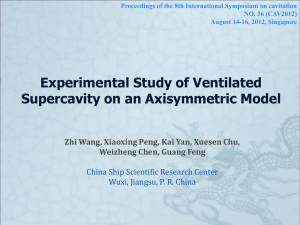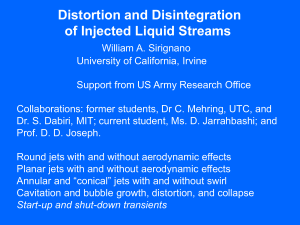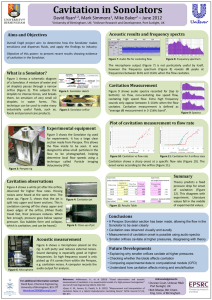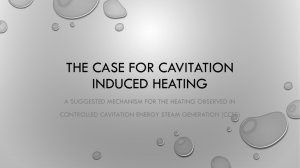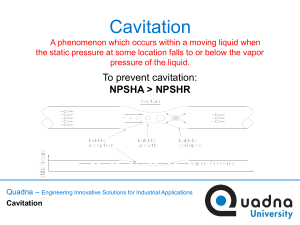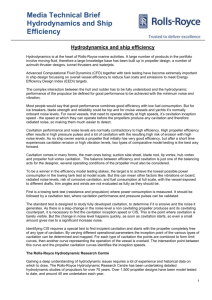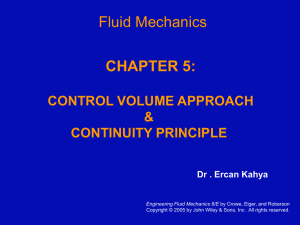Presentation 19 Oct... - University of Alberta
advertisement
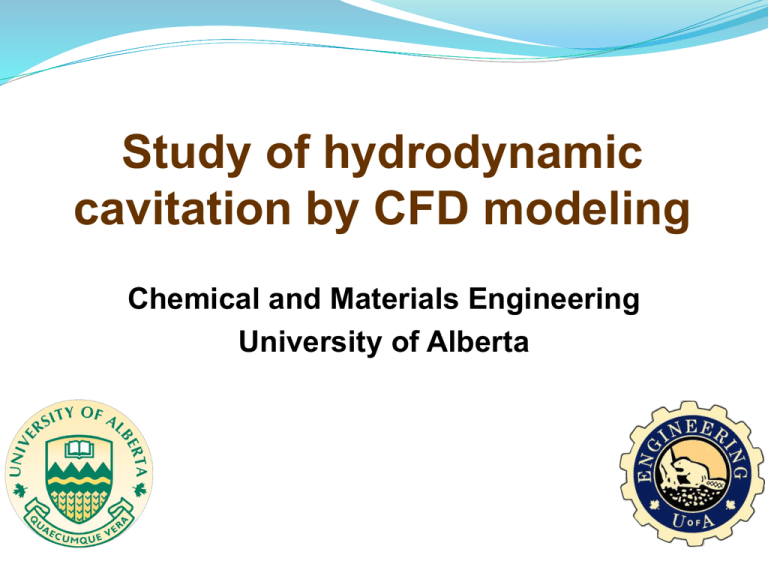
Study of hydrodynamic
cavitation by CFD modeling
Chemical and Materials Engineering
University of Alberta
Outline
Background
Milestone
Cavitation modeling
Cavitation experiments
Future work
2
Background
Objective: develop a system for enhancing fine particle flotation
using microbubbles generated by cavitation
Mechanism proposed by Zhou et al. 1997
particle
particle
tiny bubble
Flotation-sized
bubbles
Two stage
attachment
tiny bubble
Enhanced coagulation
by Bubble bridging
Hydrophobic particle surface in water is a good nucleation sites
for cavity generation
3
Milestone
Develop a model for cavitation using CFD
Apply the cavitation model in a high intensity agitation system
Determine critical variables for hydrodynamic cavitation
Determine bubble size distribution using population balance
equations
Measure bubble size distribution
Couple the cavitation and population balance equations with flow
equations
Study floatation recovery
4
HIA Cell CFD modelling
Vessel diameter, Dt
7.65 cm
Vessel height, H
7.60 cm
Baffle width, J
1.34 cm
Baffle thickness
0.55 cm
No: of Baffles
2
Impeller diameter, D
5.76 cm
Bottom clearance, C
1.5 cm
D/Dt
0.7529
J/Dt
0.175
C/Dt
0.196
CFD Modelling of cavitation is performed for the laboratory HIA cell for
different impeller speeds and different dissolved gas content.
5
Contours of pressure and volume
fraction of vapor in the HIA cell
Pressure
Volume fraction of vapor
6
Geometries
Orifice (R/r=2,3, R=2cm)
R
r
Venturi (R/r=2, R=2cm)
R
r
Contraction (R/r=2, R=2cm)
R
r
7
Pressure profile in venturi
Our model
Hu et al. 1998
Minimum inlet velocity is 4 m/s for the studied venturi
8
Pressure and velocity profiles in venturi
Single phase model
Inlet velocity=4m/s
Pressure profile (Pa)
Velocity profile (m/s)
9
Pressure profiles in orifice
Single phase model
Inlet velocity=4m/s
10
2D and 3D comparison
Single phase model
Inlet velocity=4m/s
3D
2D
11
Cavitation models
Schnerr-Sauer model
Bubble number density
Zwart-Gerber-Belamri
Bubble diameter
Evaporation coefficient
Condensation coefficient
Singhal et al. cavitation model
Non-condensable gas fraction
12
Cavitation modelling
Multiphase flow
Continuity equation for mixture
Momentum equation for mixture
Cavitation model for vapor phase
Bubble dynamics: growth of cavitation bubbles using Rayleigh-
Plesset equation
B radius of bubble
PV =vapor pressure
P=pressure
L =liquid density
13
Cavitation model
vapor transport equation
Evaporation
rate term
Condensation
rate term
When Pv ≥ P
When Pv ≤ P
V =Vapor volume fraction
k =Turbulence kinetic energy
=Surface tension
Singhal et al. (2002): Ce=0.02, Cc=0.01
14
Multiphase modelling in orifice
Continuity, turbulent flow model and Singhal et al. cavitation
model, inlet velocity: 4m/s
15
Multiphase modelling in orifice
Singhal et al. and Zwart-Gelber-Belamri Cavitation models
(inlet velocity=4 m/s)
16
Multiphase modelling in orifice
Continuity, turbulent flow model and Singhal et al. cavitation
model, inlet velocity: 4m/s and 4.5m/s
17
CFD analysis in orifice R/r=3
Velocity contours in orifice (R/r=3)
Inlet velocity= 4 m/s
Max velocity= 51 m/s
Pressure profile
Max pressure= 1.14 MPa
Min pressure= -98 kPa
vapor fraction contours
Max vapor fraction= 0.92
Cavitation model:
Zwart-Gerber-Belamri
18
3D Multiphase modelling in orifice
19
20
Experimental Setup
21
Experimental Setup
ID= 1 inch
Variable speed slurry
pump
Velocity range: 0-6 m/s
for 1 inch ID tube
22
Proposed setup
Type of contraction
Required Flow (GPM)
Required head pressure (ft)
Orifice
11.4 (1/2”)
3 (1/4”)
120 (1/2”)- 103 (1/4”)
Venturi
10 (1/2”)- 8 (1/4”)
Pump:
Centrifugal
Max flow: 66 GPM
Max head: 122 ft
Price: $ 2000
Flowmeter
Coriolis Flow and Density Meter
23
Gas holdup measurements
FBRM
0.8 to 1000 micron
Inline detection
CCD
Redlake Motionscope
517 fps @ 1280 x 1024
Min exposure time 1µs
R. J. N. Bernier, “Unsteady two-phase flow instrumentation and measurement,” Ph.D. dissertation, Cal.. Inst. Technol., Pasadena, 1982.
24
Gas holdup measurements
Acoustic spectrometer
Sonartrac
2”-36”
1-10 m/s
1-20 %
5 % accuracy
$ 16500
R. J. N. Bernier, “Unsteady two-phase flow instrumentation and measurement,” Ph.D. dissertation, Cal.. Inst. Technol., Pasadena, 1982.
25
Gas holdup measurements
Conductivity cell:
L
C=G
A
C: Specific conductivity of the solution
G: Measured conductivity of the solution
L: Distance between two plates
A: area of the plates
L/A: cell constant
Cell Constant (K)
Optimum Conductivity Range
(µS/cm)
0.1
0.5 to 400
1.0
10 to 2000
10.0
1000 to 200,000
http://www.coleparmer.ca/techinfo/techinfo.asp?htmlfile=Conductivity.htm&ID=78
26
Gas holdup measurements
Electrods:
Coaxial
Parallel flat plate
Wire grid
http://www.coleparmer.ca/techinfo/techinfo.asp?htmlfile=Conductivity.htm&ID=78
27
Future Work
Implement physical experiments to evaluate parameters in
cavitation model and population balance model
Use UDF in Fluent to model the generation of bubbles
Implement the population balance in a bubble-particle
environment
Determine bubble-particle and particle-particle collision rate
(frequency) and efficiency model parameters {experiments}
Develop comprehensive model for flotation involving in-situ
bubble generation, bubble-particle interaction and the ultimate
flotation recovery.
Study the effect design and operating parameters on fine
particle flotation
28
Acknowledgements
• Financial support for this work from:
NSERC-CAMIRO CRD Grant on Fine Particle
Flotation
NSERC-industrial Research Chair Program in Oil
Sands Engineering.
29
Thank you for your attention
30
